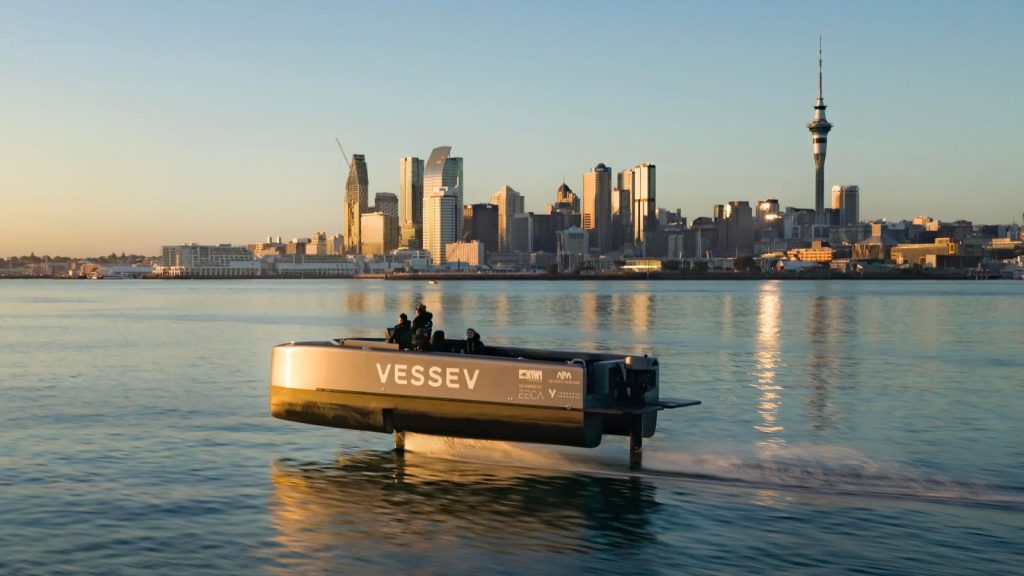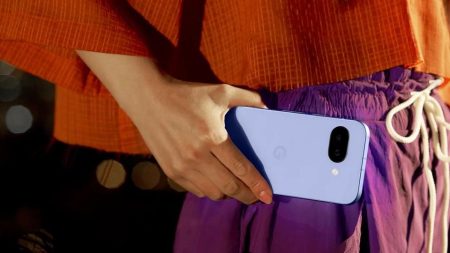Once an engineering program lead for the original Apple Watch, Eric Laakmann has morphed into a sort of ferry godfather, as CEO of marine tech company Vessev.
With Laakman at the helm, The New Zealand-based company unveiled the VS-9, what it terms the “world’s first premium tourism electric hydrofoiling vessel,” on Monday. After an initial test period going on now out of Aukland, once certified later this year, Vessev expects the VS-9 to go into commercial service through Fullers360, New Zealand’s largest ferry operator.
“It’s our intention for Fullers360 to be 100% electric or hydrogen operated by 2040 and foiling is absolutely a part of that vision for us,” said Mike Horne, Fullers360 CEO, in a statement.
The 29-foot long VS-9 can carry up to 10 passengers plus a skipper at a top speed of about 30 knots, or 34.5 miles per hour, with a cruising range of between 40-50 nautical miles, or 46-57 miles.
Unlike a conventional vessel floating on the water’s surface, a hydrofoil hovers just above the surface, typically providing a more comfortable ride since it’s not affected as much by pounding waves.
In the case of the VS-9, the company touts construction of the actual foils as a key differentiator enhancing control and passenger comfort even further while improving energy consumption.
The VS-9 uses what Vessev describes as ultra-high authority hydrofoil systems, where the foils change shape using high precision flaps under the water to optimize efficiency, based in part, on technology used in America’s Cup sailing vessels.
Vessev worked with Fullers360 and the ferry operator’s “decarbonization” partner NetZeroMaritime to develop the VS-9.
“The ability to remove the foils from the water completely is a design element we’re particularly proud of. We were told it would be impractical, but we’ve delivered a system which makes it easy for operators to maintain pristine foils for maximum efficiency. To our knowledge, the VS 9 will be the only certified passenger electric hydrofoil in the world capable of this,” said Laakmann in a statement.
The Vessev VS-9 is not the first electric hydrofoil to be used as a ferry.
This past March, San Francisco, Calif.-based startup Navier began providing a water taxi service using one of its high-speed electric, six-passenger, N30 hydrofoil boats to ferry employees of financial infrastructure platform company Stripe to and from Larkspur in Marin County to Oyster Point near the company’s South San Franciso headquarters, about 22 miles each way.
The N30, however, is largely being marketed as a recreational vessel for private use.
Acknowledging the fact there are what he termed a “handful” of recreational hydrofoiling electric vessels in the marketplace, Laakmann maintains in email responses to our questions, “there are no vessels of this type which have passed survey for use in commercial passenger applications.
Laakmann bases Vassev’s claim to be the “first hydrofoiling tourism vessel to operate in the world” on both the VS-9’s features and the arrangement with Fullers360, explaining, “We will be the first in the world to certify a vessel of this type for passenger use in commercial applications (tourism and point to point marine services). The VS—9 will be the first electric hydrofoiling vessel to be operated in commercial service by a private operator (Fullers360).”
Laakmann points out the VS-9 contains additional attributes for commercial use that include:
· Full battery structural fire protection and safety systems.
· Designs reviewed and approved by regulators (load cases, structural design, electric system, etc)
· DNV-GL design standards. “Far more significant safety systems.”
Several VS-9 have already been sold with a starting price of $620,000, according to Laakmann, declaring, “We are calling it the “Rivian of the Sea,” referring to the U.S. brand of electric pickup trucks and SUVs.
Vessev is now developing the 100-passenger capacity VS-18.
Indeed, just as the auto industry is moving more towards electric vehicles to improve the environment and reduce fossil fuel consumption, the marine sector is following suit for certain boating segments, in particular, electric hydrofoils.
“There are 33 million vessels in the world today with sustainable vessels representing the smallest fraction,” said Laakmann. “Through significant enhancements in efficiency, hydrofoiling will play a key role in this once-in-a-generation shift.”
Read the full article here









